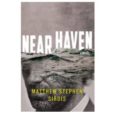May 1st, 1988. In Near Haven—Matthew Stephen Sirois’s provocative and deftly paced debut novel—it’s the date a comet is predicted to strike the Earth, ending civilization. In the face of what appears to be certain doom, society crumbles in advance of the comet—from helplessness and hopelessness, and from the violence they fuel.
But not everyone is hopeless, including the novel’s protagonist and conscience, Tom Beaumont, whose story begins about ten months before the comet’s expected arrival. A boat builder in the fictional seaside town of Near Haven, Maine, Tom is skeptical about assurances that the comet will strike, and about pretty much every other variety of received wisdom. His views isolate him from just about everyone other than his friend Neville “Nev” Bradford, who, with Tom, struggles to survive as social order dissolves.
Tom has good reason for his skepticism, and for sensing that the motivations of the doom predictors–including government officials, members of the media, and religious figures—are self-serving. (In the interest of not spoiling the story, I’ll leave the details for readers to discover.)
Sirois’s writing about the struggles of Tom, Bradford, and others in their circle is action-filled and compelling. Occasionally, it is also heartbreaking. Some time after Tom sets off an explosion that kills members of an invading convoy, he ventures out to inspect the damage:
In this passage and many others, Sirois brings to life the devastation that results from the comet-related social upheaval and from the ceaseless, often bloody competition for fuel, food, and other dwindling resources.
Still, Tom holds onto hope. An important thread running through the novel is his mission to build a seaworthy boat, thereby fulfilling the terms of an apprenticeship contract he’d made with a local boat-building enterprise.
After the head of this business dies, and after contracts and most other social conventions become irrelevant, Tom continues to work on the boat, transforming the endeavor into an active form of hope. Through this work, Tom tests both his green boat-building skills and his belief that there will be a future in which he, his vessel, and other survivors will have a role and a purpose.
In the larger context of the novel, in which most citizens uncritically accept the dark forecasts of the government and other authorities, this hope feels radical—as do Tom’s efforts to employ reason in the face of doomsaying propaganda.
That reasoning might be regarded as a radical act feels disturbingly familiar right now. So does a line spoken early in the novel by the guest on a television talk show. After the guest points to scientific consensus that the comet will be a “flyby,” the show’s host attacks her credibility, drawing on suspect sources. Her response: “You’re making reality itself a partisan issue.”
In this time of climate-change denial, and of claims that inconvenient facts are “fake news,” her remark feels more than relevant.
To end on a brighter—and hopeful—note, one of my favorite things about the novel is its portrayal of the friendship between Tom and Bradford, which withstands multiple tests, internal and external, and adds welcome sparks of humor to the story.
The bond between Tom and Bradford suggests two (implied) lessons worth taking from this insightful and timely novel: keep good friends close, and build (or keep building) something that matters to you and that points toward a future—hopefully, a brighter one. In these times, our well-being may depend on such things.
Would My Pick be Your Pick?
If you're interested in ________, the answer may be "Yes":▪ Dystopian fiction
▪ Anything written by Cormac McCarthy (especially The Road)
▪ Stories with a strong sense of place






